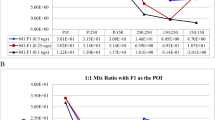Abstract
In order that there can be confidence that DNA profile frequency estimates will not place undue bias against a defendant, 2 methods are described for estimating minimum allele frequency bounds for PCR-based loci. One approach estimates minimum allele frequencies for VNTR and STR loci using sample size and the observed heterozygosity at a locus, while the second approach, appropriate for loci typed with allele-specific oligonucleotide probes, is based only on sample size. The use of a minimum allele frequency enables compensation for sparse sampling of infrequent alleles in population databases.
Similar content being viewed by others
References
Boerwinkle E, Xiong W, Fourest E, Chan L (1989) Rapid typing of tandemly repeated hypervariable loci by the polymerase chain reaction: application to the apolipoprotein B 3' hypervariable region. Proc Natl Acad Sci USA 86:212–216
Budowle B, Chakraborty R, Giusti AM, Eisenberg AJ, Allen RC (1991 a) Analysis of the variable number of tandem repeats locus D1S80 by the polymerase chain reaction followed by high resolution polyacrylamide gel electrophoresis. Am J Hum Genet 48:137–144
Budowle B, Giusti AM, Waye JS, Baechtel FS, Fourney RM, Adams DE, Presley LA, Deadman HA, Monson KL (1991 b) Fixed bin analysis for statistical evaluation of continuous distributions of allelic data from VNTR loci for use in forensic comparisons. Am J Hum Genet 48:841–855
Budowle B, Baechtel FS, Smerick JB, Presly KW, Giusti AM, Parsons G, Alevy M, Chakraborty R (1995 a) D1S80 population data in African Americans, Caucasians, Southeastern Hispanics, Southwestern Hispanics, and Orientals. J Forensic Sci 40(1):38–44
Budowle B, Lindsey JA, DeCou JA, Koons BW, Giusti AM, Comey CT (1995 b) Validation and population studies of the loci LDLR, GYPA, HBGG, D7S8, and Gc (PM loci), and HLA-DQα using a mulitplex amplification and typing procedure. J Forensic Sci 40:45–54
Chakraborty R (1981) Expected number of alleles per locus in a sample and estimation of mutation rates. Am J Hum Genet 33:481–484
Chakraborty R (1992) Sample size requirements for addressing the population genetic issues of forensic use of DNA typing. Hum Biology 64:141–159
Edwards A, Civitello A, Hammond HA, Caskey CT (1991) DNA typing and genetic mapping with trimeric and tetrameric tandem repeats. J Hum Genet 49:746–756
Edwards A, Hammond H, Jin L, Caskey CT, Chakraborty R (1992) Genetic variation at five trimeric and tetrameric repeat loci in four human population groups. Genomics 12:241–253
Ewens WJ (1972) The sampling theory of selectively neutral alleles. Theor Popul Biol 3:87–112
Gyllensten UB, Erlich HA (1988) Generation of single-stranded DNA by the polymerase chain reaction and its application to direct sequencing of the HLA-DQ alpha locus. Proc Natl Acad Sci USA 85:7652–7656
Herring G, Fildes N, Reynolds R (1994) Evaluation of the AmpliType PM DNA test system on forensic case samples. J Forensic Sci 39:1247–1253
Hochmeister MN, Jung MM, Budowle B, Borer UV, Dirnhofer R (1994) Swiss population data on three tetrameric short tandem repeat loci - VWA, HUMTHOI, and F13A1 - derived using multiplex PCR and laser fluorescence detection. Int J Legal Med 107:34–36
Horn GT, Richards B, Merrill JJ, Klinger KW (1990) Characterization and rapid diagnostic analysis of DNA polymorphisms closely linked to the cystic fibrosis locus. Clin Chem 36:1614–1619
Huang NE, Chakraborty R, Budowle B (1994) D1S80 allele frequencies in a Chinese population. Int J Legal Med 107:118–120
Huang NE, Schumm J, Budowle B (1995) Chinese population data on three tetrameric short tandem repeat loci - HUMTHOI, TPOX, and CSFIPO - derived using multiplex PCR and manual typing. Forensic Sci Int 71:131–136
Kasai K, Nakamura Y, White R (1990) Amplification of a variable number of tandem repeat (VNTR) locus (pMCT118) by the polymerase chain reaction (PCR) and its application to forensic science. J Forensic Sci 35:1196–1200
Kimura M, Crow IF (1964) The number of alleles that can be maintained in a finite population. Genetics 49:725–738
Kloosterman AD, Budowle B, Daselaar P (1993) PCR-amplification and detection of the human D1S80 VNTR locus: Amplification conditions, population genetics, and application in forensic analysis. Int J Legal Med 105:257–264
Ludwig EH, Friedl W, McCarthy BJ (1989) High resolution of a hypervariable region in the human apolipoprotein B gene. Am J Hum Genet 45:458–464
National Research Council (1992) DNA typing: statistical bases for interpretation. In: DNA Technology in Forensic Science, Chapter 3. National Academy Press, Washington DC, pp 74–96
Neel JV (1973) ‘Private’ genetic variants and the frequency of mutations among South American Indians. Proc Natl Acad Sci USA 70:3311–3315
Nei M (1975) Molecular population genetics and evolution. North Holland/American Elsevier. Amsterdam New York, p 118
Nelson SL (1978) Nomograph for samples having zero defectives. J Qual Technol 10:42–43
Ohta T, Kimura M (1973) A model of mutation appropriate to estimate the number of electrophoretically detectable alleles in a finite population. Genet Res 22:201–204
Saiki RK, Scharf S, Faloona T, Mullis KB, Horn GT, Erlich HA, Arnheim N (1985) Enzymatic amplification of beta-globin genomic sequences and restriction analysis for diagnosis of sickle cell anemia. Science 230:1350–1354
Saiki RK, Walsh S, Levenson CH, Erlich HA (1989) Genetic analysis of amplified DNA with immobilized sequence-specific oligonucleotide probes. Proc Natl Acad Sci USA 86:6230–6234
Shriver MD, Jin L, Chakraborty R, Boerwinkle E (1993) VNTR allele frequency distributions under the stepwise mutation model: a computer simulation approach. Genetics 134:983–993
Siebert PD, Fukuda M (1987) Molecular cloning of human glycophorin B cDNA: nucleotide sequence and genomic relationship to glycophorin A. Proc Natl Acad Sci USA 84:6735–6739
Slightom JL, Blechl AE, Smithies O (1980) Human fetalGγ- andAγ- globin genes: complete nucleotide sequences suggest that DNA can be exchanged between these duplicated genes. Cell 21:627–638
Valdes AM, Slatkin M, Freimer NB (1993) Allele frequencies at microsatellite loci: the stepwise mutation model revisited. Genetics 133:737–749
Weir BS (1992) Independence of VNTR alleles defined by fixed bins. Genetics 130:873–887
Yamamoto T, Davis CG, Brown MS, Schneider WJ, Casey ML, Goldstein JL, Russell DW (1984) The human LDL receptor: a cysteine-rich protein with multiple Alu sequences in its mRNA. Cell 39:27–38
Yang F, Brune JL, Naylor SL, Apples RL, Naberhaus KH (1985) Human group-specific component (Gc) is a member of the albumin family. Proc Natl Acad Sci USA 82:7994–7998
Author information
Authors and Affiliations
Additional information
This is publication number 95-10 of the Laboratory Division of the Federal Bureau of Investigation. Names of commercial manufacturers are provided for identification only, and inclusion does not imply endorsement by the Federal Bureau of Investigation
Rights and permissions
About this article
Cite this article
Budowle, B., Monson, K.L. & Chakraborty, R. Estimating minimum allele frequencies for DNA profile frequency estimates for PCR-based loci. Int J Leg Med 108, 173–176 (1996). https://doi.org/10.1007/BF01369786
Received:
Revised:
Issue Date:
DOI: https://doi.org/10.1007/BF01369786




